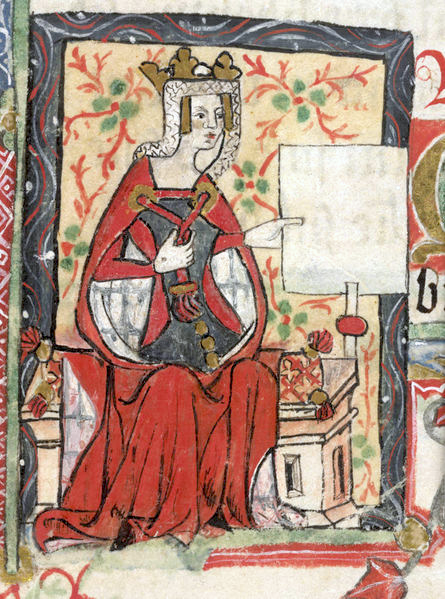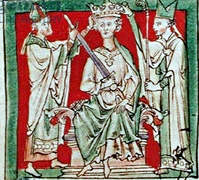by Susan Flantzer © Unofficial Royalty 2016

King Stephen of England; Credit – Wikipedia
King Stephen of England, born Stephen of Blois, was born in Blois (now in France) in either 1092 or 1096. The County of Blois was in northern France and bordered the Duchy of Normandy, the County of Anjou, the County of Poitou, and the Ile de France, the area controlled by the King of France.

Northern France around the time of Stephen’s birth; Credit – Wikipedia
Stephen was the fourth of the eleven children of Stephen II, Count of Blois and Adela of Normandy and England, a daughter of King William I of England (the Conqueror).
- William, Count of Sully (circa 1085 – circa 1150), married Agnes of Sully, the heiress to the Lordship of Sully-sur-Loire, had issue
- Theobald II, Count of Champagne (1090 – 1152), married Matilda of Carinthia, had issue
- Odo, died young
- Lucia-Mahaut, married Richard d’Avranches, 2nd Earl of Chester, both drowned in the sinking of the White Ship on November 25, 1120, no issue
- Agnes, married Hugh III of Le Puiset
- Eleanor (died 1147) married Raoul I of Vermandois, had issue, divorced; Raoul made a second marriage to Petronilla of Aquitaine, the sister of Eleanor of Aquitaine
- Alix (circa 1100 – 1145), married Renaud III of Joigni, had issue
- Adelaide, married Milo II of Montlhéry, Viscount of Troyes, divorced, no issue
- Henry, Bishop of Winchester (circa 1098 – 1171)
- Humbert, died young

Stephen’s family tree, with his mother Adela at the top, and, left to right, William, Theobald, and Stephen; Credit – Wikipedia
Stephen’s father died in 1102 during the Crusade of 1101 fighting in the Second Battle of Ramla. After his father’s death, Stephen and his siblings were brought up by their capable mother who served as regent during the minority of her eldest son. Stephen was raised in his mother’s household rather than being sent to a close relative as was the common practice. He was taught Latin, history, and Biblical stories by his tutor William the Norman.

Stephen’s uncle. King Henry I of England; Credit – Wikipedia
Stephen’s maternal uncle was King Henry I of England. Even though Stephen’s family had regional power, as the third surviving son in the family, he could use the support of a powerful patron such as King Henry I of England. Around 1113 – 1115, Stephen first visited his uncle’s court in England. He soon became a favorite of his uncle who bestowed upon him lands won in battle, the County of Mortain (in France) and Alençon in southern Normandy. In 1125, King Henry I arranged for Stephen to marry Matilda of Boulogne, the only surviving child and heiress of Eustace III, Count of Boulogne and Mary of Scotland, daughter of King Malcolm III of Scotland and Saint Margaret of Scotland. Matilda would be the Countess of Boulogne in her own right. Boulogne was a county within the Kingdom of France from 896 – 1501, centered on the city of Boulogne-sur-Mer, a coastal city in Northern France.
Stephen and Matilda had three sons and two daughters:
- Baldwin of Blois (circa 1126 – 1135)
- Eustace IV, Count of Boulogne (c. 1129 – 1153) married Constance of France, no children
- Matilda of Blois (circa 1133 – circa 1137), died in childhood
- Marie of Blois, Countess of Boulogne (circa 1136 – 1182) married Matthew of Alsace, had two daughters
- William of Blois, Count of Boulogne (circa 1137 – 1159) married Isabel de Warenne, no children
Five years before the marriage of Stephen and Matilda, a terrible tragedy caused a succession crisis in England. The White Ship, carrying King Henry I of England’s only legitimate son William Ætheling, sank as it left France to sail to England, and William Ætheling drowned. Empress Matilda was King Henry I’s only legitimate child, and on Christmas Day of 1126, Henry had his barons swear to recognize Empress Matilda and any future legitimate heirs she might have as his successors.

The sinking of the White Ship; Credit – Wikipedia
After the sinking of the White Ship, Stephen and his wife Matilda stayed close to King Henry I and lived most of the time in England realizing that Stephen was very close to the throne. Henry’s daughter Empress Matilda had left England as a child to marry Holy Roman Emperor Henry V. The marriage was childless and Holy Roman Emperor Henry V died in 1125. After her husband’s death, Empress Matilda went to the royal court in Normandy (Kings of England were also Dukes of Normandy). Eventually, King Henry I made arrangements for his daughter to marry Geoffrey V, Count of Anjou in 1128. The marriage was not a happy one. The couple often lived apart and failed to produce a child until 1133.

Stephen’s first cousin, Empress Matilda; Credit – Wikipedia
On December 1, 1135, King Henry I of England died. Stephen quickly crossed the English Channel from Boulogne to England, accompanied by his military household. With the help of his brother, Henry of Blois, Bishop of Winchester, Stephen seized power in England and was crowned king on December 22, 1135. Matilda of Boulogne was unable to accompany her husband because she was pregnant, so she was crowned on Easter Day, March 22, 1136. Empress Matilda did not give up her claim to England and Normandy, leading to the long civil war known as The Anarchy between 1135 and 1153.

Coronation of King Stephen; Credit – Wikipedia
During the civil war, Matilda of Boulogne proved to be her husband’s strongest supporter. Matilda was as strong and resourceful as Stephen was weak and indecisive. When England was invaded in 1138, Matilda rallied troops from Boulogne and its ally Flanders, and successfully besieged Dover Castle. She then went north to Durham, where she made a treaty with King David I of Scotland in 1139. After Stephen was captured at the Battle of Lincoln in 1141, she rallied Stephen’s supporters and raised an army with the help of William of Ypres, Stephen’s chief lieutenant. It was Matilda of Boulogne who recaptured London for Stephen and forced Empress Matilda to withdraw from the siege of Winchester, leading to Stephen’s release in 1141 in exchange for the Empress’ illegitimate brother and chief supporter Robert FitzRoy, 1st Earl of Gloucester.

Battle of Lincoln; Credit – Wikipedia
By the mid-1140s, the fighting had slowed down and there was a stalemate and the succession began to be the focus. Empress Matilda returned to Normandy in 1147. In the same year, the Empress’ husband and her eldest son Henry FitzEmpress, the future King Henry II, mounted a small, unsuccessful mercenary invasion of England. Empress Matilda remained in Normandy where she focused on stabilizing the Duchy of Normandy and promoting her son’s rights to the English throne.
Matilda of Boulogne died of a fever on May 3, 1152, at Hedingham Castle in Essex, England. She was buried at Faversham Abbey in Kent, England which she and her husband had established. Perhaps if she had not died and her husband had not lost his strongest supporter, the result of the civil war would have turned out differently.
On August 17, 1153, Stephen and Matilda’s eldest surviving son Eustace died. Ironically, this was the same day that the first child of Henry FitzEmpress, the future King Henry II, and Eleanor of Aquitaine was born. The child, William IX, Count of Poitiers, survived for only two years, but he was followed by seven siblings, two of whom became Kings of England.

King Stephen standing with a falcon, and King Henry II seated on his throne; Credit – Wikipedia
Shortly after Eustace died in 1153, Stephen and Henry FitzEmpress reached a formal agreement known as the Treaty of Wallingford (or Winchester or Westminster). The treaty allowed Stephen to keep the throne until his death but forced him to recognize Empress Matilda’s son Henry FitzEmpress, as his heir.

The supposed tomb of King Stephen, his wife Matilda, and their son Eustace at St. Mary of Charity Church; Credit – www.findagrave.com
Stephen survived his wife by a little more than two years. He died apparently of appendicitis at Dover Castle on October 25, 1154, and a line of 14 Plantagenet kings who ruled until 1485 started. Stephen was buried with his wife Matilda and his son Eustace at Faversham Abbey which Stephen and Matilda had founded. All three tombs were lost when Faversham Abbey was demolished during the Dissolution of the Monasteries during the reign of King Henry VIII. Their remains were reportedly thrown into the nearby Faversham Creek. Their empty tombs were unearthed in 1964 near what had been the center of the choir. At St. Mary of Charity Church, the parish church in Faversham, there is a tomb where it is said that the remains of King Stephen, his wife Matilda, and his son Eustace were reinterred after the destruction of Faversham Abbey.
Sharon Kay Penman’s excellent historical fiction novel When Christ and His Saints Slept deals with The Anarchy and most of the historical figures mentioned here are characters.
This article is the intellectual property of Unofficial Royalty and is NOT TO BE COPIED, EDITED, OR POSTED IN ANY FORM ON ANOTHER WEBSITE under any circumstances. It is permissible to use a link that directs to Unofficial Royalty.
England: House of Normandy Resources at Unofficial Royalty
